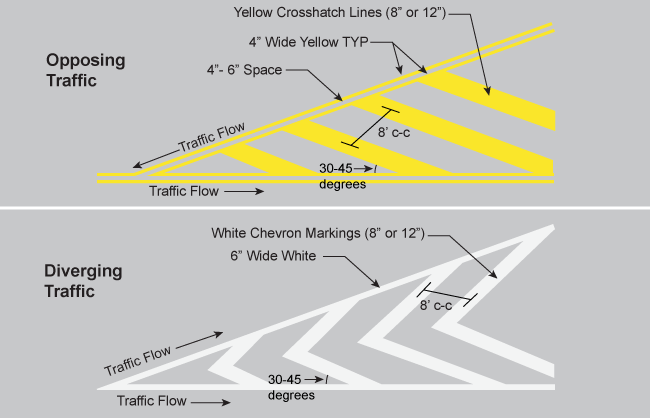Crosshatch Markings

Cheveron and diagonal crosshatch markings define an area, within defined boundaries, over which vehicular traffic is discouraged. Crosshatch lines should be sloped in the direction of the major flow of traffic. They must comply with the MUTCD standards. These markings may be used on certain paved areas such as shoulders, flush median areas, etc. The color of the marking is determined by the direction of travel on either side of the marked area. Crosshatching should conform to the following standards:
** When crosshatch markings are used in paved areas that separate traffic flows in the same general direction, they shall be white and shaped as chevron markings, with the point of each chevron facing toward approaching traffic.
** When crosshatch markings are used in paved areas that separate opposing directions of traffic, they shall be yellow diagonal markings that slant away from traffic in the adjacent travel lanes.
** When crosshatch markings are used on paved shoulders, they shall be diagonal markings that slant away from traffic in the adjacent travel lane. The diagonal markings shall be yellow when used on the left-hand shoulders of the roadways of divided highways and on the left-hand shoulders of one-way streets or ramps. The diagonal markings shall be white when used on right-hand shoulders.
Crosshatch markings should be at least 12 inches wide for roadways with a posted speed limit of 45 mph or greater, and at least 8 inches wide for roadways with a posted speed limit of less than 45 mph. The longitudinal spacing of the markings should be determined by engineering judgment considering speeds and desired visual impact. Often, the local state DOT has guidelines concerning the minimum number of chevron/diagonal markings to be used and/or pavement marking standards. Additionally, the chevrons and diagonal lines should form an angle of approximately 30 to 45 degrees with the longitudinal lines that they intersect.


